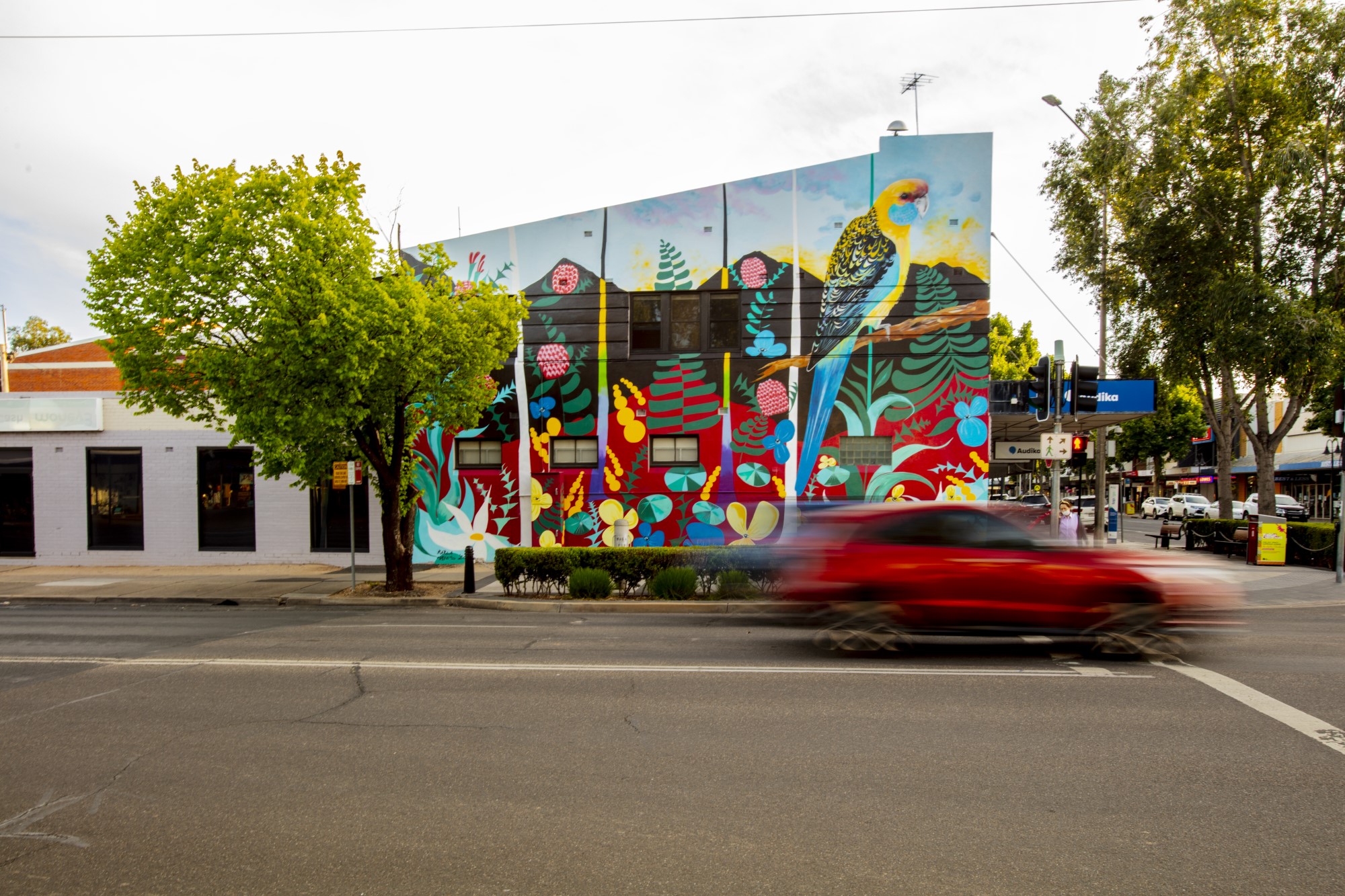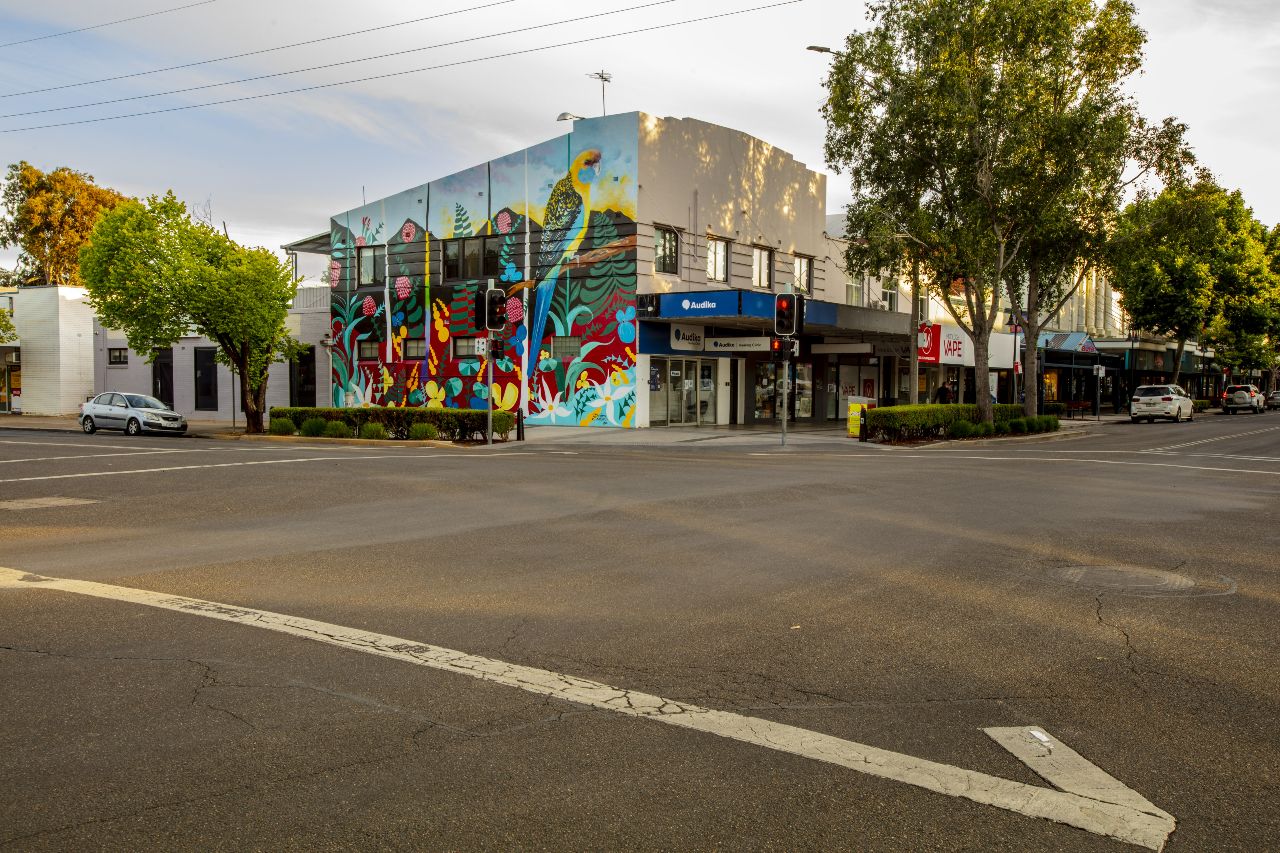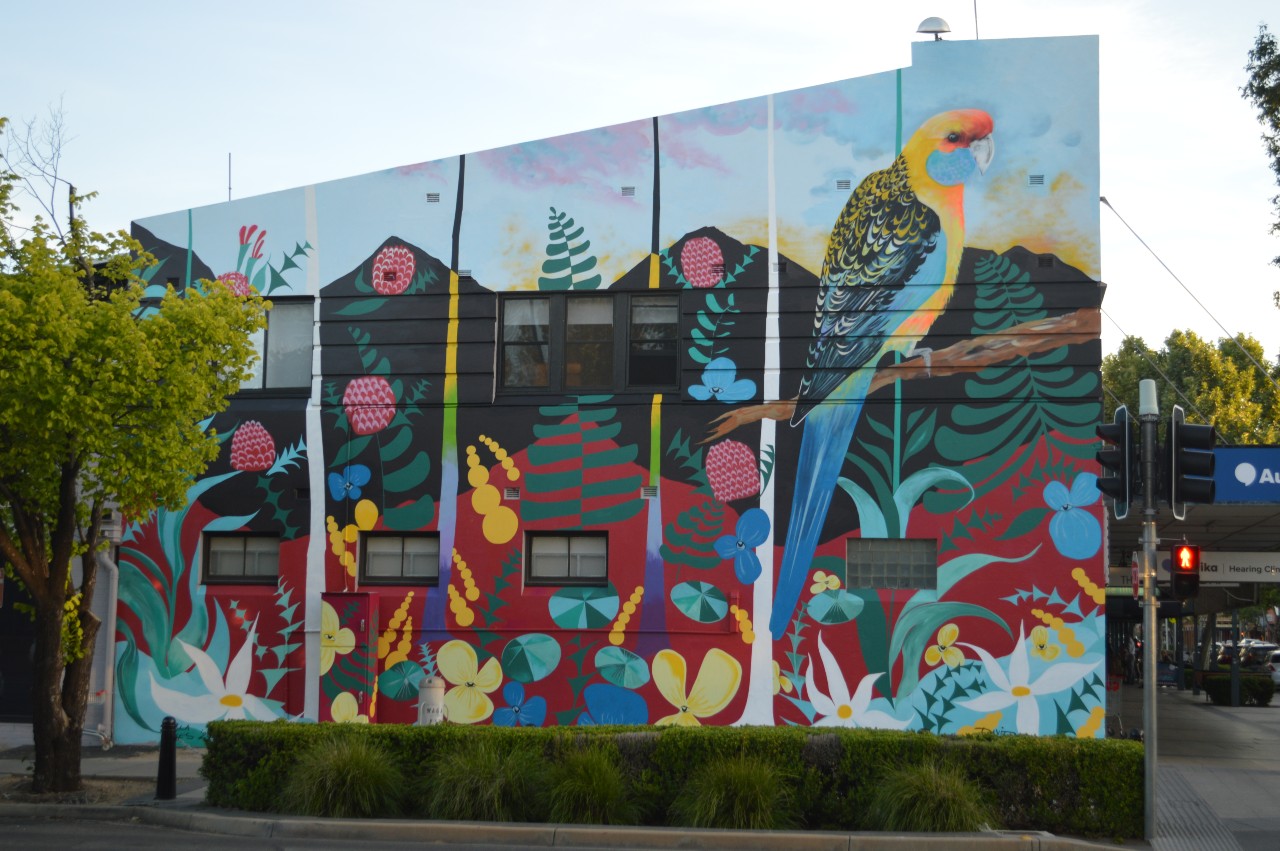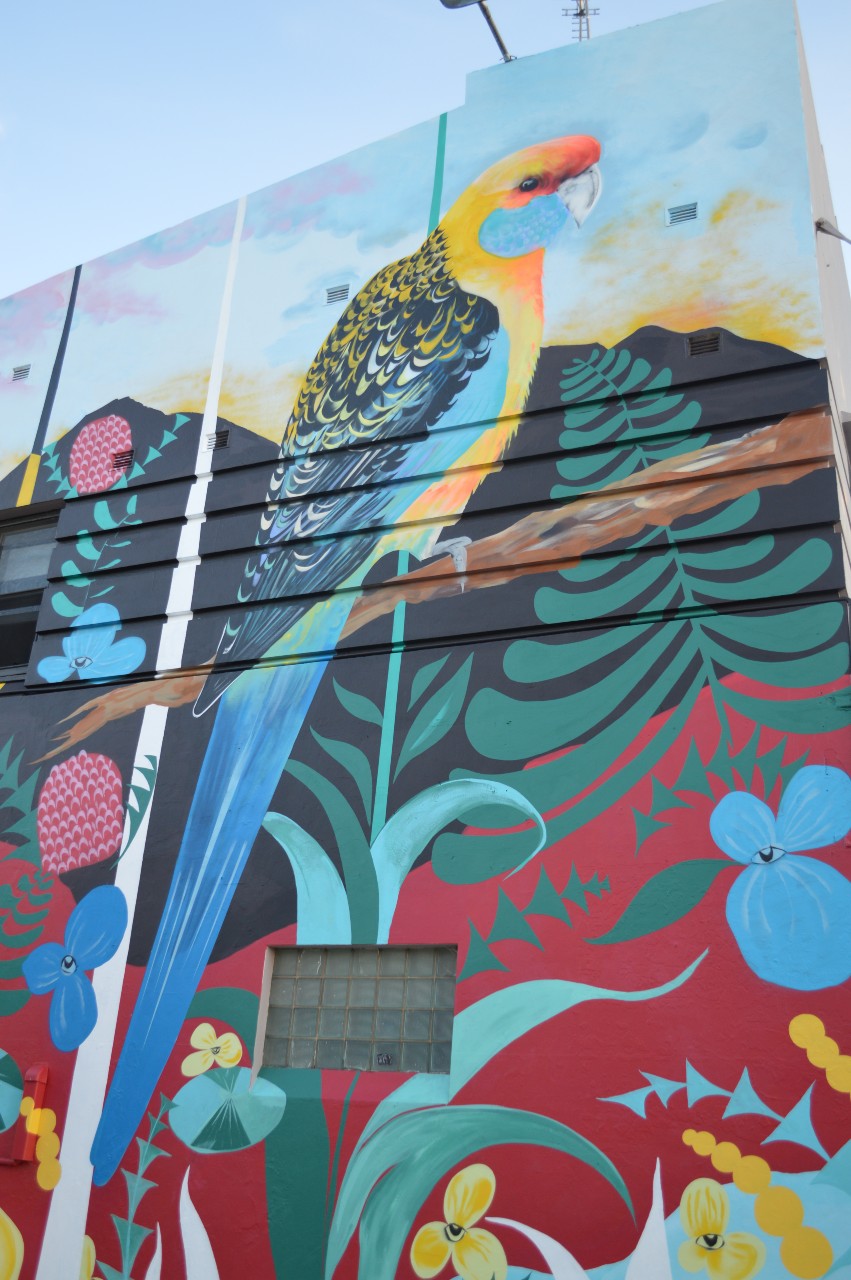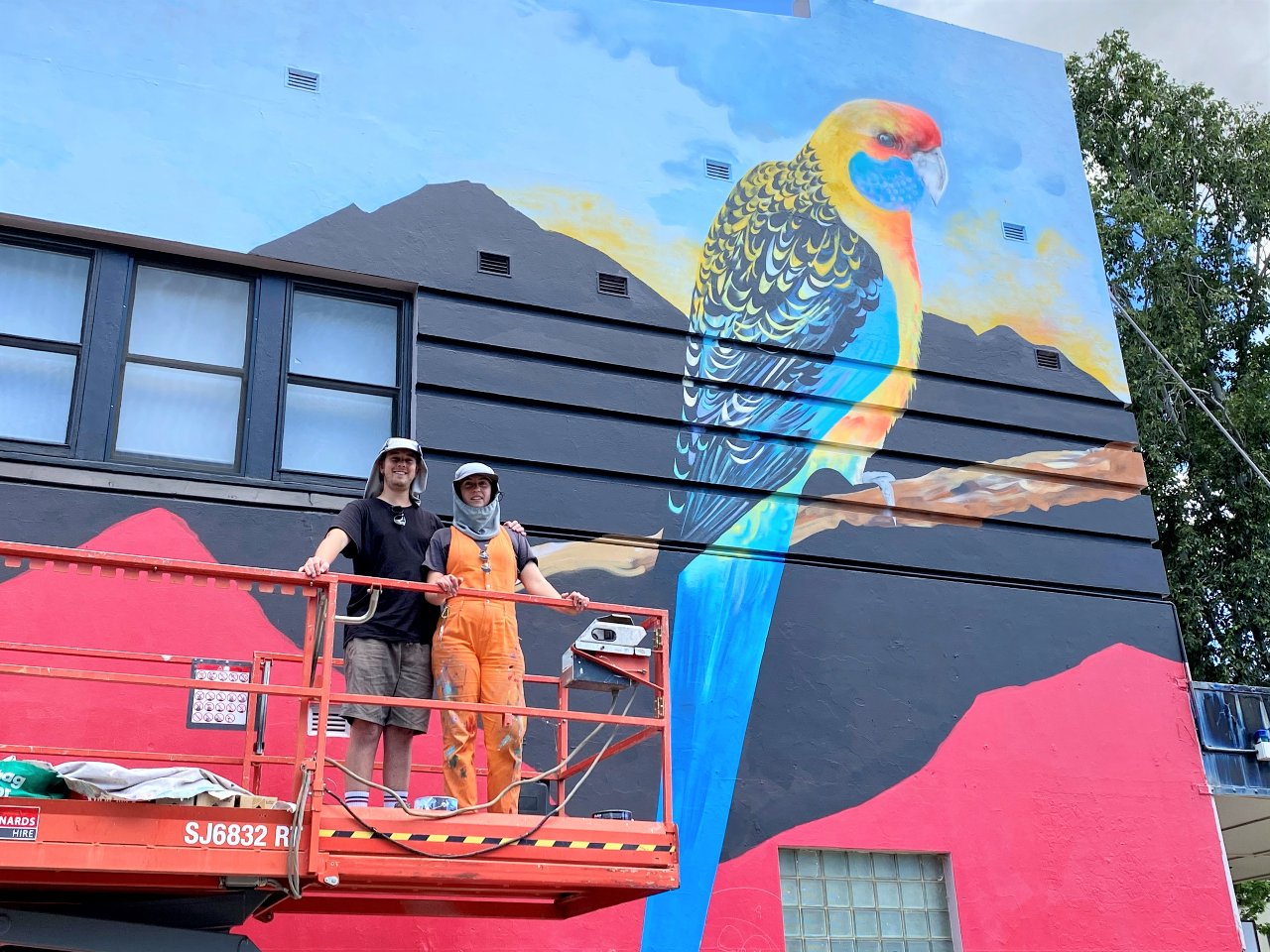Paint and aerosol
Cnr Baylis and Tompson Streets, Wagga Wagga
Public Art Audio Trail
Episode 8: Morning Light
Audio visual description:
Acknowledgement spoken by Bernard Higgins.
Narration, content and interview by Ashleigh Adams.
Sound and music by Sam Webber Sound.
Public Art Audio Trail - Episode 8 Transcript - Morning Light
Wiradjuri Acknowledgement of Country
gulbali-yanhi ngurambang-gu Wiradjuri-gu walumaldhaany-galang. nganha bala mayiny Wiradjuri. yindyamali-yanhi mudyiganggalan-bu balumbambal-bu balugirbam-bu yindyamali-yanhi bagaraygan nguarambang-gawali-i yandu muran wigi wagga wagga-dha.
Wagga Wagga City Council acknowledges the traditional custodians of the land, the Wiradjuri people, and pays respect to Elders past, present and future and extends our respect to all First Nations Peoples in Wagga Wagga.
Meditative music plays and continues to the end of the episode.
Narrator: Abundant with native flora and fauna, David Cragg’s mural, Morning Light depicts a thriving oasis in the bustling centre of town.
Sounds of bird life and the call of the Yellow Rosella.
Located on the corner of Tompson and Baylis streets, Morning Light by multidisciplinary artist David Cragg was commissioned by Wagga Wagga City Council as part of the NSW Department of Planning, Industry & Environment’s Places to Love program. Completed in October 2020, David was assisted on this large-scale work by artist Karla Hayes.
Morning Light brightens and re-invigorates this special corner of central Wagga Wagga. The work features the local Yellow Rosella, otherwise known as the ‘Murrumbidgee parrot’, as well as the Banksia and Blue Commelina flowers. These species are endemic to the Riverina and have important uses as traditional food and medicine.
As the sunrise paints vibrant colours onto the native flora, the mural highlights Wagga’s landscape, teeming with life as the beautiful Murrumbidgee parrot basks in the morning light.
Dr Sam Bowker is a Lecturer in Art History and Visual Culture and is the Sub-Dean for Research and Graduate Studies at Charles Sturt University’s Wagga Wagga campus. He was part of the commissioning process for this project and is passionate about its significance.
Narrator: Why are public artworks like this one so important for the community?
Sam: Well I feel that the best public art reveals to the community, and its visitors, what that community regards as most important about their lives and the places they live. They are openings to conversations, whether you are a new visitor in the area, or a long time local, public art should celebrate what that place has been in the past and what it aims to be in the future. It should be like an excellent tour guide, taking you through a place and making you feel engaged with that places history and sense of potential. I feel that public art that doesn’t engage with a site specifically leaves you feeling a bit lost, it could be located anywhere in the world, but when you see a public artwork that reflects that community then you are really learning more deeply about what it is to be part of that place.
Narrator: The Yellow Rosella really is the star attraction of this work, can you tell me a bit about its significance?
Sam: Well this really is a very special parrot. This particular bird, the Murrumbidgee Rosella as I call it or the Yellow Rosella, is a sub-species of the Crimson Rosella that may be more familiar to people towards the coastline from here. And the Crimson Rosella of course is a bright, strident bird with a clear pell of a call like a bell that rings out from the canopy. Our Yellow Rosella is a little different, it’s slightly quitter, it’s better camouflaged. And it’s only found close to the Murrumbidgee and Murray Rivers. Indeed, the further away you move from the river the more orange appears in its feathers until you arrive at true Crimson Rosellas further away from the rivers edge. So this is not only an endemic bird to our region, but it has a very clear distribution map which follows the course of the rivers. This is a very special part about living in regional Australia, our beautiful, colourful, noisy birdlife.
Narrator: As a Wagga resident, can you tell me about the impact this mural has had on the vibrancy of the street?
Sam:Well I’ve been told it’s caused traffic accidents as people pause to look, but I don’t think that’s entirely true, just like the 5 o’clock wave at the beach. I think this mural has enhanced the street tremendously by adding a point of vivid contrast and indeed a new Wagga landmark. To talk about the intersection of Tompson and Baylis Streets is simply a mark on a map, but to say you’ll meet someone at the bright yellow parrot, people know where that is. I also find it remarkable the way that the top end of the murals background integrates with different forms of weather, between a lightly clouded sky or a sunset to a clear vivid blue of our summer days in particular, the mural seems to dissolve the edge of the building and turns it into something that is much more exciting as a statement of place and our ecology than a statement of the architecture of the building itself.
Narrator: There are a number of public artworks that can be found throughout the Wagga Wagga CBD and suburbs that are part of the Wagga Wagga City Council Public Art Collection. As you continue along Baylis Street you can find statues, tiled artworks, sculptures, and if you look up you might spot a few Little Crows that live atop of the street signs. Please enjoy discovering the collection that celebrates Wagga Wagga and brings our public spaces to life.
This podcast is produced by Wagga Wagga City Council with funding from the Australian Government’s Culture, Heritage and Arts Regional Tourism program.
Audio Description
This striking mural is on the side of a building that is 6 meters high and 14 meters wide. The building has six grey windows facing the street, each window has a black frame.
This mural depicts a mountain range, almost in silhouette against a pale blue sky with a hint of white clouds. The top halves of the mountains are black while the lower parts are maroon.
Starting from the bottom left of the mural is a large white flower with a yellow centre, similar to a flannel flower. Behind this and reaching up are flame-like shapes in shades of turquoise, and a green fern-like tendril consisting of inverted triangles in ever-decreasing sizes, with a small off-shoot reaching up behind the small windows where they cross and support a large banksia. Two red lily-like flowers and another fern are painted against the mountain peaks.
The middle section of the mural contains a different assortment of flowers. Repeated in this section is the banksia, along with small blue flowers and yellow flowers throughout. There are small ferns and leaves amongst the flowers. There are several small rows of ever-decreasing wattle-like orange circles throughout the section.
The focal point of this mural is a colourful yellow rosella perched on a horizontal brown branch. Its yellow head sits in the top right against the pale blue sky with its blue tail almost touching the ground. It is looking to the right.
A large fern sits to the right of the bird. A white flower rests on the bottom with floating shapes: an orange fern, a turquoise circle above it and to the left.
Explore the Trail
This artwork is a part of the Public Art Audio Trail, follow the link below to see all the artworks on the trail.
About the Artwork
Morning Light is a large-scale mural celebrating the local flora, fauna and landscape of Wagga Wagga. In 2020 Wagga Wagga City Council commissioned artist David Cragg to activate this wall space as part of the NSW Department of Planning, Industry & Environment’s ‘Places to Love’ program. Cragg focused on depicting flora species endemic to the Riverina, specifically important native plant foods and medicines. The hero of the piece is the Yellow Rosella, sometimes known as the ‘Murrumbidgee Parrot’, which is commonly found in this region. Cragg was assisted by artist Karla Hayes.
David Cragg is a multidisciplinary artist of Irish, Scottish and Bundjalung ancestry, working in Dharawhal Country (Illawarra Region of NSW, Australia). He has exhibited painted works, murals, public installations and performed live art. Cragg’s works often embodies a reflection of and exploration on the effects humans have on the Australian Country through contrasting sweeping landscapes of Australian bush with varied industrial elements.

